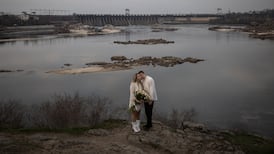Crash investigators said on Tuesday night it was too soon to determine the cause of a frontal collision between two regional trains in southern Bavaria that killed at least 10 and injured many others.
The crash, Bavaria’s worst in 40 years, occurred at about 6.40am on Tuesday when two trains, carrying a total of 150 people and each travelling at about 100km an hour, collided as they rounded a curve on a single-rail stretch near Bad Aibling.
The trains were partially derailed as they ploughed into each other. One driver and two conductors were confirmed dead at the scene, along with six passengers. A tenth person died on Tuesday afternoon hospital, where up to 18 seriously injured were treated.
Other passengers suffered less serious injuries and shock. One person, believed to be the other driver, was still missing, and Bavarian politicians warned that further victims may be found.
One passenger, who identified himself as Patrick, said he was listening to music and reading a book when he heard a massive bang.
“I was knocked forward, when I opened my eyes it was dark all around and I heard people screaming,” Patrick said from a hospital in nearby Rosenheim. “When we got out, we saw our compartment was still on the track but the first two compartments were completely deformed.”
He watched as other blood- drenched survivors limped or dragged themselves from the wreckage and rescue teams arrived.
The crash took place on a slope between a wood and a canal, difficult to reach by road, triggering a dramatic four-hour air rescue.
Helicopter rescue
Some 10 helicopters were deployed, with rescuers abseiling down to airlift passengers to safety. Some were trapped in the trains and had to be cut out, while others had already freed themselves.
By early afternoon the 600- strong rescue team concluded the initial recovery operation, allowing the first blue-and-yellow pieces of mangled train wreck to be removed on Tuesday evening.
The crash scene was quickly sealed off, visible only through trees. Federal transport minister Alexander Dobrindt called it a “terrible, shocking sight”.
“One train literally drilled its way into the other and tore the second train’s cabin apart,” he said.
Crash investigators, who began studying three black box recorders from the trains, say it is too soon to know whether the incident was caused by human error, faulty signals or another issue.
One of the trains was believed to be running late, causing speculation that one of the drivers overrode security measures designed to prevent trains travelling in opposite directions simultaneously on the single-line stretch.
Security review
Five years after a similar crash claimed 10 lives on an eastern German regional line, some investigators have demanded a review of security on regional lines.
Germany’s high-speed train lines have an electronic system to prevent collisions, but the regional network – in particular, single-line stretches – are equipped only with magnetic oscillator circuits at critical points along the track, designed to trigger a train’s brakes automatically if it passes a red signal.
The train track is operated by state-owned Deutsche Bahn rail company. The three-year- old trains operating the service belong to Upper Bavaria Railways, a subsidiary of the French Transdev group.
The crash in southern Germany sent shockwaves throughout the country, with political parties all cancelling Wednesday's traditional Ash Wednesday political rallies.
Amid the tragedy, locals were counting their blessings that the crash took place in the winter holidays.
“Those are two trains that are normally used by children who live in the locality to go to school,” said Jürgen Thalmeier, police spokesman in Rosenheim.










